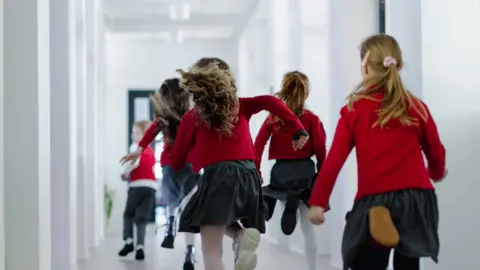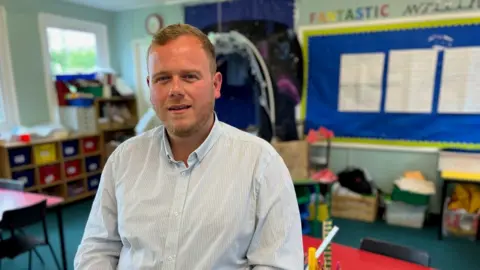Estimated 700,000 pupils in unsafe or ageing schools in England, says watchdog
 Getty Images
Getty ImagesAn estimated 700,000 children are being taught in unsafe or ageing school buildings in England that need major repairs, according to a report.
The National Audit Office (NAO) report says the Department for Education (DfE) has, since 2021, assessed the risk of injury or death from a school building collapse as "very likely and critical".
Teachers have told the BBC about risks posed by sewage leaks and asbestos.
The DfE says it has been "significantly investing in transforming schools".
An official said "nothing is more important" than safety at school - and the department had allocated more than £15bn since 2015 to keep schools safe and operational.
But the NAO, the UK's independent public spending watchdog, said risks had not been addressed because of years of underfunding.
It said the deteriorating condition of school buildings was damaging pupil attainment and teacher retention.
Steve Marsland, head teacher at Russell Scott Primary School, in Manchester, said his head is filled with "worry and panic" over keeping the 460 children at his school safe after raw sewage came up through the floors "on many occasions".
"We had a plummet in attendance through sickness after the sewage floods, it is an absolute disgrace.
"It has been going on since 2015 and is down to poor building practice," he told BBC Breakfast.
He said energy bills before his building was rebuilt were between £12,000 to £15,000 a year, but then went up to £45,000 a year, and was now nearly £9,000 a month because of rising energy costs.
Tameside Council said it shared Mr Marsland's disappointment at the building work carried out in 2015, and supported the school's application to the DfE for funds to rebuild the school.
The NAO's report found regional variations in how much money needed to be spent per pupil to put schools back into good condition.
The East and West Midlands had the greatest average need per pupil, followed by parts of northern England.
The report found more than a third (24,000) of all English school buildings had passed their estimated initial design life.
And it highlighted continuing concerns for school buildings that still contain reinforced autoclaved aerated concrete (RAAC) - a lightweight form of concrete prone to collapse, used widely between the 1950s and mid-1990s.
The DfE has identified 572 schools where RAAC might be present, so far confirming it in 65, of which 24 required immediate action.
The NAO also said a safety risk from asbestos was also more severe in poorly-maintained buildings.
 BBC/Branwen Jeffreys
BBC/Branwen JeffreysKate Chisholm, executive head teacher of Oakfield Schools Federation, in Gateshead, said her school buildings were "full of asbestos" as they were built in the 1960s.
Speaking to BBC Radio 4's Today programme, she said: "Our buildings are all glass-facing as well, so last year when it was very hot, our buildings got up to 40C and we had to shut the school."
Her Year 2 teacher Philip Clayton said temperatures in his classroom hit 32C earlier in the month. Despite leaving doors open and using fans, he says it often becomes "unbearable".
"It becomes very sweltering, and very difficult to concentrate, so despite best efforts... it can be a big challenge for staff and pupils alike to work.
"Staff are trying their very best to provide high-quality education, but the building really doesn't support us in delivering that."
Ms Chisholm said although the school was "on its knees", it was still not expected to see major repairs any time soon.
"There has been a lack of centralised funding from the government over the last few decades, which has meant the local authority hasn't been able to maintain the schools, even though they wanted to," she said.
In a written response to Liberal Democrat MP Munira Wilson, in February, the government said at least 39 schools had had to close since December 2019, over various safety concerns.
The NAO said the DfE had recommended minimum funding of £5.3bn per year to mitigate the most serious risks of building failure, in its 2020 spending review, with £7bn per year being the "best-practice" level.
But the department was subsequently given an average of £3.1bn per year from the Treasury.
 BBC/Hazel Shearing
BBC/Hazel ShearingRachel Jones, head teacher at Kingsley St John's Primary School, in Cheshire, says her school building is suffering from "completely stretched" budgets.
"Most of the cuts that are being made in school are on the building, because I'm putting things off," she says.
"We're using gaffer tape instead of having things replaced."
Ms Jones feels "embarrassed" showing prospective parents around the school, despite the "excellent" standard of teaching.
"You're constantly making apologies and it's a constant battle to overcome those first impressions," she added.
'Case-by-case basis'
A separate NAO report, also released on Wednesday, found the DfE had insufficient plans for making state-funded school buildings in England more environmentally friendly.
Responding to both reports, the National Education Union's joint general secretary Kevin Courtney said the government was spending "nothing like enough" on school buildings.
"That not only has an impact on education. If you're not sure which buildings might collapse, or if there is asbestos in the buildings which isn't well managed, then there are risks to life and limb as well," he added.
A DfE official said the government was investing in 500 projects for new and refurbished school buildings, through its school-rebuilding programme.
Academy trusts, local authorities and voluntary-aided school bodies were responsible for the maintenance of schools and should contact the department with concerns.
"We will always provide support on a case-by-case basis, if we are alerted to a serious safety issue by these responsible bodies," the official added.
The government does not have to respond to the NAO's recommendations, but the report will be used as evidence in an ongoing parliamentary inquiry into the state of schools.
